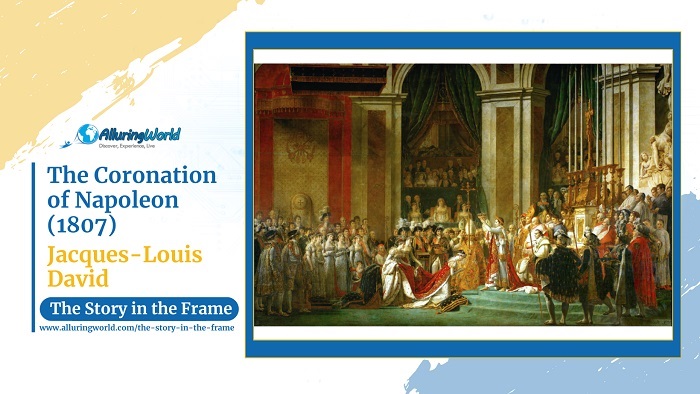Painted between 1805 and 1807, The Coronation of Napoleon is one of the grandest and most significant works that were created by Jacques-Louis David. Commissioned by the Emperor of the French, Napoleon Bonaparte himself, this monumental painting captures the opulent and highly orchestrated coronation ceremony which was held on 2 December 1804 at Notre-Dame Cathedral in Paris, the capital of the French First Republic. Spanning nearly 10 m (33 ft) in width and 6 m (20 ft) in height, the artwork immortalizes a pivotal moment in history when Napoleon crowned himself Emperor of the French, marking the establishment of his reign and the transformation of France into an empire.
About the Painter:
Jacques-Louis David (1748–1825) was the leading artist of the Neoclassical movement and a key figure in the political and artistic landscape of the late 18th and early 19th centuries. A fervent supporter of the French Revolution, David initially aligned himself with revolutionary ideals, producing works such as The Death of Marat that became symbols of the period, however, after the fall of Robespierre, he shifted his allegiance to Napoleon, becoming his official painter. David’s style was marked by precise composition, historical accuracy, and a deep understanding of classical influences, making his works not only artistic masterpieces but also powerful political tools.
Inspiration and Reasons Behind the Painting:
Napoleon commissioned this painting to serve as an enduring symbol of his legitimacy, power, and divine right to rule the Empire, and as he sought to control the narrative of his coronation, ensuring that his image would be remembered not as a conqueror who seized power but as a ruler chosen by destiny, this painting shows the ceremony itself which was filled with symbolic elements designed to reinforce Napoleon’s authority, including his decision to crown himself rather than be crowned by Pope Pius VII—an act that demonstrated his independence from the Catholic Church. As Jacque-Louis was always meticulous in historical accuracy and grandeur, he worked closely with Napoleon to craft a composition that glorified the emperor while reinforcing the stability and grandeur of the new regime.
What is Depicted in the Painting:
The painting presents the moment when Napoleon crowns his wife, Empress Joséphine, as she kneels before him. This choice of moment is significant, as it shifts the focus from Napoleon’s self-coronation to an act of generosity and legitimacy, as it reinforces the idea of a stable dynasty, and as the scene is set within the grand interior of Notre-Dame Cathedral, adorned with soaring columns and intricate decorations that heighten the sense of magnificence, the Pope Pius VII can be seen seated to the right, as he is raising his hand in blessing, though he plays a secondary role, emphasizing Napoleon’s supremacy. To the left, Napoleon’s family, court officials, and military leaders watch in solemn admiration, and among them is his mother as well, Letizia Bonaparte, as she is prominently featured, despite having not attended the ceremony. This was something like an example of David’s willingness to alter reality to serve the emperor’s image, so that it would solidify Napoleon’s rule.
Colors and Techniques:
The use of color in this grandiose painting is rich and regal since it is dominated by deep reds, golds, and whites, which reflect the grandeur of the event, but the warm tones of the robes contrast with the cooler hues of the architectural elements create a unique depth and atmosphere. His attention to detail is quite meticulous, from the embroidered patterns on Napoleon’s coronation robe to the soft textures of Joséphine’s gown, and in addition, the lighting is strategically placed to illuminate the central figures, guiding the viewer’s eye to the moment of crowning. The composition is balanced yet dynamic, with figures arranged in a structured yet lifelike manner, adding to the sense of realism and grandeur.
Conclusion:
In conclusion, The Coronation of Napoleon is not just a historical record, but it is a carefully crafted vision of power, legitimacy, and imperial grandeur, and the painter’s ability to blend historical accuracy with artistic idealization resulted in a masterpiece that continues to captivate audiences today. More than two centuries later, this painting remains a powerful symbol of Napoleon’s legacy, reflecting his ambition, his vision of empire, and the lasting impact of his reign on French and European history.

